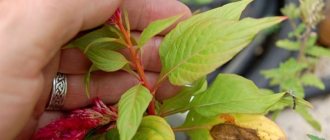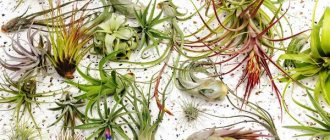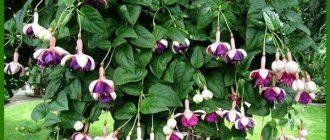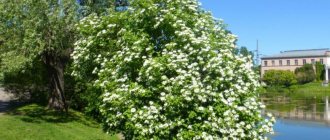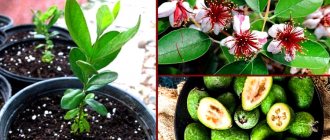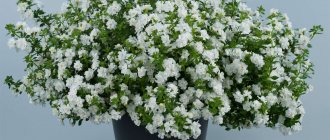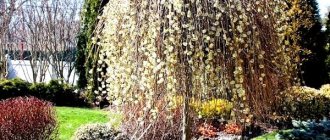Saxifraga: varieties and varieties
The name of this beautiful herbaceous plant hints at the fact that saxifrage grows and develops even in hard-to-reach places. Its sophisticated bright flowers can easily destroy the strongest stones and “settle” in the resulting cracks. The Saxifraga family is diverse and multifaceted, it has about 200 species. The beauty and unpretentiousness of saxifrage contribute to their active use in modern landscape design. The most popular today are 2 types of these perennial plants.
Saxifraga is a very unusual and attractive plant for your garden.
Soddy saxifrage. It looks like a dense turf of rosettes with dissected leaves. This species does not bloom for long, only 3-4 weeks in June. For it, planting in slightly acidic open ground rich in humus will be optimal.
Soddy saxifrage
This type of saxifrage boasts the following varieties:
- Rose-koenigen (bright pink shade);
- Purpurmontel (purple color);
- Triumph (ruby red hue).
Arends saxifrage. This plant will delight you with its rich green color all year round. Its leaves form a continuous carpet up to 15 cm high. The flowering period is late spring - early summer.
Saxifraga Arends
The most popular varieties of this saxifrage:
- Peter Pan (bright red buds);
- Sleeping Beauty (red flowers);
- Floral Carpet (a scattering of pink and purple flowers);
- Snow carpet (white buds).
In addition, there are shadow, Manchurian, reed, paniculate, round-leaved, wicker and other types of saxifrage. Some of them can be seen in the photo.
Saxifraga rotundifolia
Species recommended for gardening
There are several hundred types of saxifrage, the most popular are the following:
- Saxifraga ascending - Saxifraga adscendens;
- K. rigidifolia – Aizoides;
- K. prolomnikovaya – Androsacea;
- K. mossy - S. Bryoides;
- K. drooping – S. Cernua;
- K. soddy - S. Cespitosa;
- K. cymbal - Cymbalaria;
- K. granular - S. granulata;
- K. hawkweed - S. Hieraciifolia;
- K. swamp - S. Hirculus;
- K. hypnumovaya – Hypnoides;
- K. Korzhinsky - S. Korshinskyi;
- K. snowy - S. Nivalis;
- K. oppositeifolia - S. oppositifolia;
- K. brook – S. Rivularis;
- K. three-toed – S. Tridactylites.
When choosing a type of saxifrage for the garden, you should take into account their requirements; not every species can grow in a flower bed. To meet the expectations of plants, you need to know their natural habitat and try to reflect it in your own garden. For best results, you will need a rockery with a drainage layer. Mountain plants prefer drier conditions and will do much better on this type of rock.
The least demanding, as well as the most common species in gardens include:
- Saxifraga Arends – Saxifraga × arendsii Arends;
- K. paniculata - S. paniculata;
- K. shady or shady - S.umbrosa;
- K. rigidifolia – Aizoides;
- K. hawkweed - S. Hieraciifolia;
- K. Fortune – Saxifraga fortunei;
- K. mossy - S. Bryoides;
- K. cotyledon – S. cotyledon;
- K. rotundifolia – S. Rotundifolia;
- K. longifolia - S. Longifolia;
- K. short-pointed or lush (cushion) – Saxifraga × apiculata.
Let's take a closer look at the most common types, as well as the features of their planting and cultivation.
Arends
The most popular variety is Saxifraga Arends, which is a garden variety derived from crossing different species of the genus Saxifraga (mainly Saxifraga rosacea and Saxifraga hypnoides) growing wild in Europe and Asia.
The plant takes the form of low, cushion-shaped bushes that display decorative leaves and flowers. The leaves are wedge-shaped, deeply carved, juicy, green. Arends saxifrage flowers are variegated - white, red, pink, carmine (different shades). The plant is very low, reaching a stem height of 5 cm, not counting the peduncles, which reach 15-20 cm. Flowers appear in May.
Planting and caring for Saxifraga Arendsa does not cause any problems. Unlike its highland cousins, it is much less demanding. To grow beautifully, the plant needs to be given a slightly semi-shady position.
Preferred soil:
- humus;
- lime;
- permeable;
- quite wet.
Humidity is a very important factor in determining the beautiful appearance of a plant. During periods of prolonged drought, water shortages should be replenished. It is important to avoid open positions where Arends saxifrage may suffer in winter.
Saxifragas of this species are most easily propagated by division, although they can be propagated by seedlings in the form of unrooted rosettes. Plants are divided after flowering (from June to August), then they are easily accepted. Seeds are sown in boxes in the spring - they are not covered with soil, only slightly pressed to the ground. Seedlings need to be pricked 2-3 times.
The perennial is distinguished by its versatility of use and is used for:
- low plant - ideal for rock gardens, rockeries;
- planting along the walls;
- flower beds;
- outline of tracks;
- grows well on the edges of water bodies;
- flowers can be cut into bouquets.
| Variety | Photo |
| “Feuerwerk” – a saxifrage variety characterized by carmine flowers | |
| "Highlander Red" - with red flowers. | |
| "Ingeborg" - dark red variety | |
| "Rosenzwerg" - low variety with carmine-colored flowers | |
| “Butter Creme” – with cream flowers | |
| "Schneezwerg" - low variety with white flowers | |
| "Peter Pan" - with carmine-colored flowers, stem height 10-15 cm | |
| "Weisser Zwerg" - white flowers, 5 cm high | |
| "Purpurteppich" - dark red flowers | |
| "Triumph" - with dark red flowers. | |
| "Schneeteppich" - white delicate flowers |
Shadow
The hybrid originated from two species Saxifraga x spathularis and Saxifraga umbrosa. One of the most beautiful saxifrages, preferring semi-shaded and shady positions, humus and fairly moist soil. The decorative appearance of saxifrage is given by leathery leaves collected in rosettes, which in the “Aureopunctata” variety are also variegated (yellow).
The leaves have a grooved edge, the flowers are collected in loose panicles, star-shaped, white with a red center. The height of the flowering bush can reach 30 cm. Flowering occurs in May. It reproduces best by division. Ideal for shady rockeries as a ground cover.
| Variety | Photo |
| "Aureopunctata" - an original variety with very decorative yellow variegated leaves | |
| "Elliott" - the variety is characterized by smaller size, pink flowers | |
| "Variegata" - with yellow spotted leaves |
Paniculata
A type of saxifrage that deserves attention is paniculata (Saxifraga paniculata), decorative due to leaves collected in rosettes and inflorescences collected in loose umbrellas. Blooms in May – June. The rosette that creates the flower shoot dies after flowering. Before flowering, the height of the plant usually does not exceed 10 cm. The height of flowering saxifrage reaches 20-25 cm. It is found naturally in Europe and Asia. It has a compact pillow-shaped shape.
Paniculate saxifrages are grown in sunny rockeries, protected from the wind, in well-lit, warm, dry places.
The soil should be:
- permeable, well drained;
- moderately fertile;
- limestone;
- The species can grow in rocky soil poor in nutrients.
Paniculate saxifrage is frost-resistant. The species reproduces by division. It can be planted in autumn or spring. Seeds are sown in summer. Young seedlings should be watered on hot days; older ones tolerate drought well. Regular weeding is important for maintenance. The plant does not require fertilizer.
Usage options:
- decoration of rock gardens;
- creating flowerbed edges;
- looks good planted among stones, in the crevices of walls;
- creates interesting compositions with young plants and sedum.
It is better not to plant paniculate saxifrage with expansive plants; they will quickly choke it.
| Variety | Photo |
| "Atropurpurea" - dark red flowers | |
| "Rosea" - pink flowers |
Fortune
An Asian beauty that blooms only in autumn, Saxifraga Fortune delights with leaves that form beautiful rosettes. The wavy edges of the leaves and the red color of the underside give the plant a decorative touch. Against the background of the leaves, cream or pink flowers collected in loose inflorescences look beautiful.
For the cultivation of Saxifraga Fortune to be successful, it must be provided with a shady position, humus, fertile, permeable and moist soil. The plant prefers an acidic environment.
| Variety | Photo |
| "Snow Conwy" - with beautiful brownish leaves on which delicate, white flowers look great |
Cotyledon
Saxifraga cotyledon is a less demanding species, found in its natural habitat in the Alps. The height without flowering shoots is 10-15 cm, during flowering the height reaches 50 cm. Fleshy and serrated leaves form large rosettes from which the peduncle grows. After flowering the rosette dies, but before this happens it will create many new rosettes. White flowers appear in June, forming paniculate inflorescences.
For successful cultivation, it is important to take care of a permeable substrate. In terms of planting location, the plant is very tolerant and grows well in sunny and semi-shaded positions. Cotyledon should not be grown in an overly alkaline environment; slightly acidic or neutral soil is ideal.
A hardy species, it is most easily propagated by division.
Opposite foliage
The perennial saxifrage oppositeifolia in its natural environment (Alps) creates low carpets. The height of the plant can reach 5 cm, during flowering it is much higher. Thanks to its numerous flowers, the plant is very decorative during flowering (spring).
The plant should be provided with permeable soil and a quiet place, preferably in light partial shade.
Cortusifolia
In spring and summer, small bunches of beautiful carved leaves 5-8 cm wide with long petioles can be mistaken for a variety of heuchera. However, this is a completely different plant - Saxifraga cortusifolia, native to China, Japan or Korea.
This species owes its name to leaves similar to those of the mountain currant (Cortusa matthioli). In autumn, this unusual species gives a pleasant surprise - it creates inflorescences 40 cm high, consisting of several dozen small, usually white flowers 1.5 cm in size. Breeders have also obtained pink varieties. In the autumn garden they all delight.
Khosta
An interesting species is the Hosta saxifrage (Saxifraga hostii) - an evergreen perennial. The name saxifrage is associated with hosta. Both of these plants were discovered and described by Nikolai Thomas Host, an Austrian botanist.
Hosta saxifrage produces low rosettes of leaves up to 15 cm in diameter. The leaves are dark green, narrow (1 cm wide), long (up to 10 cm). Rosettes of leaves turn red in autumn. From the middle of the rosette in June - July, tall (up to 60 cm) inflorescences develop, on a thin, unbranched stem - “leg”. The flowers are white, sometimes purple spotted. Individual flowers are collected in panicles (5-20 flowers per inflorescence).
Saxifraga Hosta grows best in well-drained, calcareous soil in a sunny, dry location. This is a plant with high frost resistance. Does not require winter protection.
The plant is often used for:
- rock gardens;
- planting on slopes;
- along the walls;
- can be planted in wide and flat pots on the terrace.
Plants should be planted in small groups of several to create evergreen cushions.
Soddy
The perennial saxifrage soddy is ideal for rockeries. The plants create low, flat rosettes that look like soft green cushions. The leaves are small, evergreen, pinnate. Small, white, five-petaled flowers grow on thin, reddish peduncles, growing up to 10-15 cm in height. It blooms at the turn of April - May. Often the rosette that created the flower dies after the plant has flowered.
The species grows best in semi-shaded or sunny positions. If in full sun, it requires frequent watering. The soil should be well-drained, slightly moist, humus, and calcareous.
Soddy saxifrage looks better in the company of stones. It can also grow in low beds, walls, between paving slabs or in pots. Plants are planted in small groups in close proximity to other perennials with similar requirements. After flowering, flower stalks should be trimmed.
The species is propagated by division in the spring. Plants (especially young ones) can freeze in cold and snowless winters, so you need to cover them with spruce branches.
Mossy
Saxifraga bryoides L. – the mossy saxifrage is found in the mountains of Central Europe. The small perennial forms dense turf. The entire plant is pale or yellow-green, with older leaves silvery-gray. The plant produces numerous inflorescences and several flower stalks. This is a high-mountain species (rudophyte).
In the axils of the leaves there are large inflorescences with rose-shaped petals. Thick, fleshy leaves 3-7 mm long, lanceolate with sharp edges and sharp bristles, characteristically curved upward. Single flowers on unbranched, low (1.5-5 cm) peduncles. The flowers are light yellow and orange spotted.
musky
Found in the mountains of Southern and Central Europe. In the east, the range extends through the northern Balkans, the Caucasus and Altai to the Sayan Mountains.
This is a sod-bearing species with a height of 2-12 cm. The entire plant is pubescent with soft hairs. The stem is straight, light green. The leaves are light green, with a gradually tapering base. Flowers grow at the tops of peduncles, forming a tuft or panicle, yellow-green in color.
| Variety | photo |
| "Cloth og Gold" |
Saxifraga care
Give these stunning perennials some love and care and they will reward you with fantastic blooms. They need regular watering in moderate doses, as well as fertilizing with fertilizers (once a month). The soil around plants should always be loose and weeded.
Saxifraga will feel very good in a rock garden or rock garden.
Stone rock gardens are often laid around saxifrage bushes, which serve as a kind of protective barrier for the roots from the scorching sun and help retain moisture.
When the saxifrage fades, the above-ground part of the plant is cut off. This procedure is necessary for the appearance of new leaves. These perennial plants tolerate the winter season well. If severe frosts occur, it is better to cover the saxifrage.
Proper cultivation of saxifrage involves several important nuances in care:
- avoid heat (create relative shade);
- provide flowing watering (make drainage).
The plant can thrive with minimal care.
Planting and care
Where to plant?
Saxifraga is not a capricious flower; it likes any soil, except those that are too acidic. It feels good even on clay. You can choose any place for the flowerbed: sun or shade - it doesn’t matter.
Landing Features
To plant a saxifrage plant, cool time is necessary, then the seedlings will take root without much loss. It is best to plant saxifrage in a checkerboard pattern. Over time, shoots will grow, covering the surface of the flowerbed. Plants can be replanted throughout the growing season, you just need to take the soil along with the carpet.
An alpine slide with stones is the best planting option, since the plant does not tolerate stagnant water. It is also necessary to choose the right neighbors for the saxifrage so that the ground cover plant cannot choke them out.
Planting rules:
- Make shallow holes in the prepared and spilled soil. This work must be done 24 hours before planting.
- Seedlings or rooted cuttings are placed in the center and the hole is filled with soil.
- The earth is pressed well around the outlet.
- Water carefully, avoiding erosion of the roots. The ideal watering option is along the edge of the hole.
Reproduction of saxifrage
Saxifraga is propagated in several ways. It is grown from seeds, new representatives are obtained by rosettes or by dividing the bush.
The culture is very easily propagated by rosettes
begin propagation by rosettes only after flowering has ended. To do this, the rosettes are very carefully separated from the bush, rooted in fertile soil, and then watered. For planting, you should choose a place that will be protected from the scorching sun. Only in spring are plants planted in open ground.
Another method of propagation involves obtaining seedlings after planting the seeds of the plant in open ground. The seeds are scattered on the surface of the nutrient substrate and lightly patted with the palm of your hand. The seedlings are picked and transplanted into peat pots. Seedlings are planted in open ground together with pots in June, maintaining a distance of 7 to 25 cm.
Such propagation methods will be simple for both experienced and novice gardeners.
Saxifraga seeds
Planting saxifrage seeds for seedlings
Growing saxifrage from seeds is easy. It is necessary to properly prepare the soil, containers and planting material, and sow it correctly.
Preparing containers and soil
You can buy ready-made soil for seedlings or make a mixture yourself. The following components are taken in a ratio of 1:5:10:20:
- lime (can be replaced with chalk);
- vermiculite;
- sand;
- peat land.
For growing seedlings, you can choose different containers - plastic containers, small boxes, cups. It is important to organize drainage holes, since plants do not like stagnant moisture. The size of containers should be oriented towards a specific variety.
At first, seedlings can be grown in one box or large container, then picking will be required. Individual containers are filled with a mixture of peat and sand.
There is another option - to plant saxifrage seedlings in peat tablets.
Seed preparation
Saxifraga seeds require stratification before sowing for seedlings. After this treatment, seedlings appear faster, plants become stronger and more resilient. Algorithm:
- Place the seeds in a shallow container.
- Apply a thin layer of wet sand.
- Seal the container with a transparent lid.
- Place the container in the refrigerator for three weeks.
For convenience, seed stratification can be done directly in the seedling container. It needs to be filled with soil, and planting material should be spread on top in a thin layer. After stratification is completed, move the container to a bright place at a temperature of 18-20 °C.
How to sow saxifrage
After stratification, the seeds can be sown:
- Fill seedling containers with moist soil mixture.
- Spread the seeds on the surface.
- There is no need to cover the crops with soil.
Cover the container with the planted saxifrage seeds with film, glass or a transparent lid and place it on a light windowsill. The optimal temperature for germination is 18-20 °C.
Seed germination takes 1-3 weeks - the period depends on the variety and quality of the seed
No watering is needed until seedlings emerge. Daily ventilation and removal of condensate are required.
Diseases and pests
Saxifraga is quite resistant to pests and diseases. However, unfavorable growing conditions or improper care can cause it to become infected or damaged by pests.
Dryness can cause damage to the plant by spider mites. In this case, a whitish web will be visible on the saxifrage. Later, the mite infects the leaves, they become covered with yellow spots, dry out and gradually die. Excessive moisture leads to the appearance of powdery mildew or damage to the leaves of the plant by rust, which is created by a variety of fungi.
Spider mite
The most dangerous pests for these perennial plants are scale insects and green aphids.
What do saxifrage seeds look like?
Photos of saxifrage seeds show that the grains are small in size, no more than 1 mm. Their shape is round, with a slight point at the tip, the shell is dark and hard.
Saxifraga from seedlings is a perennial ground cover up to 20 cm tall. It has flexible thin stems and carved leaves and bears red, yellow or white flowers. It quickly spreads throughout the area, for which it is valued by gardeners - with the help of the crop you can quickly cover empty lawns.
Saxifraga: combination with other plants
Growing saxifrage will bring you tremendous pleasure. All their varieties look very original and impressive, especially in combination with other plants. Irises, muscari and many other low-growing crops can share their proximity. Amazing combinations of saxifrage with lingonberries or Chinese-decorated gentian will help fill your exterior with beauty and originality.
Saxifraga in landscape design
Botanical description
Saxifraga (lat. Saxifraga) is a genus of perennial plants that includes approximately 370 species. Some species are one- or two-year-old. The literal translation from Latin is “to break a stone.” Saxifraga grows its roots into stones and breaks them over time. Distributed in temperate zones and in colder places, they belong to the Saxifraga family. In indoor floriculture, only saxifrage (Saxifraga stolonifera) is grown. This plant grows well at low temperatures and low humidity. The leaves are usually round in shape, the base of the leaf is heart-shaped. Inflorescences are racemose or panicle-shaped. Saxifraga looks most beautiful when grown as a hanging plant. If you plant several rosettes in one pot, then with age they will send out hanging shoots, on which smaller rosettes will grow, thinner shoots will grow, and even smaller rosettes will grow on them.
Saxifraga in landscape design
With its mesmerizing beauty, saxifrage has earned its rightful place in modern landscape design. It is placed in rock gardens, on artificial slides, embankments and rocks, where it looks very stylish and impressive. This plant will instantly turn an empty and unattractive rocky place into a chic flower garden. The richness of its varieties and shades will fill the surrounding space with bright, rich colors. That is why saxifrage is absolutely irreplaceable for landscape design.
Outdoor care
Saxifraga is an unpretentious flower. It is enough to adhere to the rules specified in the following sections and the grass gap will retain its high decorative value for a long time.
Watering
Note to flower growers:
- Under natural conditions, saxifrage grows in areas where there is no stagnation of liquid.
- Soil moistening is carried out moderately, the intensity of watering is slightly increased during the growing season: spring and summer.
- It is not difficult to understand that another addition of liquid is required: the soil around the saxifrage is completely dry.
- Take lukewarm, settled water.
- Watering is carried out in the evening or early in the morning.
Important details:
- If it often rains in the region and the water often stagnates, then you need to build a good drainage layer in each hole or choose a different type of plant for planting on the site.
- The substrate must meet the requirements specified in the section of the article “Soil and drainage”. If the soil mixture is sufficiently loose and there is sand or gravel in the base for saxifrage growth, the risk of liquid stagnation after rains or with excessive watering is lower.
- It is simple to prevent the problem of waterlogging: saxifrage is planted on alpine slides (in the upper part and on the sides of the composition) so that water flows freely along the inclined surface.
How can you tell if a plant is getting enough water? Saxifraga grows well, there is no yellowing of the leaves. With excess moisture, the leaf plates wither, wrinkle, and a dirty white, grayish or black coating appears - a sign of rotting. You can also hear an unpleasant odor from the affected roots if you bend close to the ground.
Feeding and fertilizer
Mineral substances are added in moderation: a week after planting seedlings and twice a month during the spring and summer. It is convenient to use liquid fertilizers for indoor flowers. The concentration of the compositions is reduced by 2 times, especially for young plants.
Many gardeners make the mistake of overusing nitrogen in the hope of activating leaf growth. The result of improper feeding is negative: the underground part begins to rot, the roots die, and yellow-brown areas appear on the leaf blades. It is more useful to add a little superphosphate and peat to the hole when planting seedlings.
Many gardeners recommend fertilizers with natural ingredients: the compositions are safe and effective. Agricultural stores sell Succinic Acid (suitable for indoor and garden flowers), Biohumus - a unique eco-product based on organic matter processed using Californian red worms.
Types of saxifrage: photo
Plant card
There are more than 400 species of saxifrage in nature, but not all of them are suitable for growing in gardens and household plots.
Botanical description:
- class: perennial (less often annual) herbaceous plant, saxifrage family;
- height: 20-50 cm, depending on the type (short or tall);
- planting time: early summer, June;
- flowering time: summer, from June to August;
- location: sunny, open areas, partial shade is acceptable;
- flower size: small, up to 3 cm, form numerous umbrella or paniculate inflorescences;
- frost resistance is high, tolerates frosts down to -40 degrees.
The perennial does not require complicated care, tolerates cold well and is suitable for growing in northern regions.

